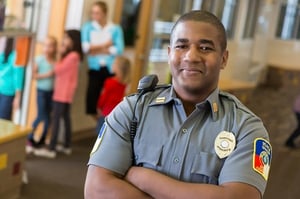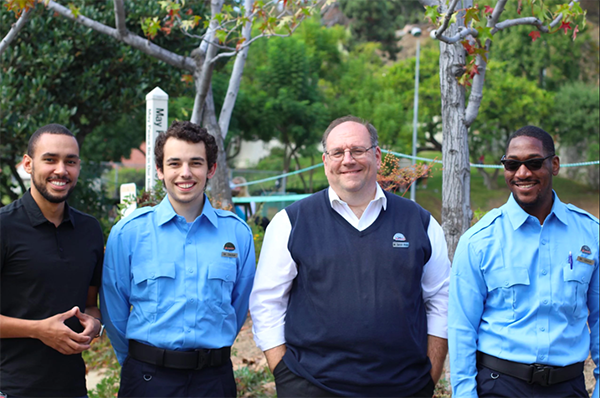There are many signifiers of a great security team. Good school security officers build excellent relationships with all groups and members of your school community, maintain professional bearing and behavior, and, yes, protect the community from active shooters. However, as you read throughout our guide, you will discover that the job of providing a safe school environment goes well beyond preparing for the worst-case scenarios. While it is important to acknowledge the data on shootings you see below, you should also note that your security team will tackle a wide variety of campus responsibilities on a daily basis (taking them off your plate!), even as they remain vigilant for serious emergency situations.
A security team’s primary goal is to provide a safe environment. This task includes preparing for the event of a school shooting. With casualties from school shootings on the rise, training a security team to identify potentially harmful people and situations before they escalate is increasingly important.
According to the FBI, 250 active shooter incidents occurred between 2000 and 2017. These events have increased in frequency. In 2000, there was one incident with seven people killed. In 2017, there were thirty incidents with 729 casualties due to an active shooter (138 killed and 591 wounded).
From this period of 2000-2017, fifty-two of these events occurred at a school.
The Center for Homeland Defense & Security tracks, according to the website, “each and every instance a gun is brandished, is fired, or a bullet hits school property” from 1970 to the present. The CHDS accumulates data on a variety of aspects, including time of day, type of firearm, age of the shooter, and the cause of the shooting. Escalation of dispute exceeds all other categories for cause of shooting - indicating that training in de-escalation techniques is key to a security team.
Here’s the truth. Adding on-site security officers to your campus is an excellent way to improve your school’s safety, security, and emergency preparedness. Here’s some more truth: it can be a challenging and potentially overwhelming mission.
This guide to hiring, evaluating, and maintaining a great security team breaks down that large goal into achievable and understandable tasks. Navigate to the specific section you want through the list above or read along as we delve into how to make it happen! We promise it’s easier than it seems.
How to Assess Your Security Needs
In order to create a physical security plan, it is vital to first assess your security needs. Physical security is the protection against any physical threats, which covers issues that may arise in the real world as opposed to a cyber setting. Each campus has unique vulnerabilities that need to be addressed in order to proceed.
Assess any identified risks or other concerns you may have. List past security issues as well as potential dangers you already know about. Walk through your campus, doing your best to assess risk and understanding threats and vulnerabilities.
Create a physical security audit checklist. Key points to consider in a checklist would be:
NOTE: Each of the above categories of security assessment should further be expanded with campus-specific questions.
Based on the checklist, choose suitable controls to mitigate the listed risks such as cameras, gates, security officers, visitor management systems including identification, etc. Create, communicate, and implement policies and procedures for the security team. Procedures will include post orders, which are directions for individual security officers’ posts.
Once your security plan is in place, audit and assess the success of your controls. Review whether your security level has improved appropriately after defined intervals. If you find major issues, correct them accordingly. Give post order revisions to the security team.
Physical security assessment is critical in safeguarding the campus grounds, buildings, traffic control, fire life safety systems, mailrooms, cleaning services, and other resources associated with the facility. Reviewing your security plan is especially important in protecting students and staff. Without a good policy of physical security assessment, it is difficult to manage your campus without high risk factor.
READ MORE: The Basics of Threat Assessment

When selecting security personnel for your campus, focus on finding officers who have professional experience and training as well as the ability to communicate and integrate with your campus culture. If you are not hiring a professional security firm to staff your security resource, there are a few things to keep in mind as you hire security officers.
First and foremost, make sure that any officer you hire has a guard card or other state licensure. State agencies perform background checks on the people they certify and, for safety and risk management reasons, you want to be sure that your candidates have no prior criminal history. Many schools also perform their own specialized background checks, obtaining more detailed information on a prospective hire’s suitability for work in an environment with children.
Once these basic thresholds are met, assess whether your potential officers have training specific to working in a school community. Most states provide resources for specific training in school security. These programs help familiarize officers with rules about locker searches, ways to defuse situations, boundaries for appropriate physical contact, and guidelines for communicating with children - skills which are essential to successful engagement on any campus.
You will also want to find candidates who are interested and engaged in the community and the culture of your organization. Ensure potential officers have an appropriately authoritarian manner while still being accessible and friendly to all members of your community. Officers should be able to maintain a strong command presence while still smiling and greeting everyone in a warm and friendly manner. When students feel comfortable with the officers assigned to their school, they are more likely to feel safe and supported. They are also more likely to ask for help or report any unusual things they might see or hear.
READ MORE: Decided to change security firms? Read our how-to article before the switch!
How to Train Officers for a School
The training required to obtain a guard card covers the basics of serving as a security officer but does not provide much helpful information on working in specific environments. Officers stationed on a school campus will be called upon to support a variety of functions and participate in multiple interactions with clients at all levels - students, faculty, administrators, guests, alumni, government officials, board members, and community leaders. For this reason, ensure that guards on a school campus receive specific training to help them communicate on different levels and determine the best approach for a given audience or situation.
Due to the significant amount of legislation and precedent regarding school safety and child protection laws, school officers should also be trained on the requirements of serving as a mandated reporter, identifying appropriate and inappropriate physical interactions between students and adults, and being aware of the unique challenges children face in the way they interact with the world around them.
Remember that security officers are often giving the first impression of a campus community. Therefore, they should be fully trained on the culture of their campus and have a general understanding of what is expected from each member of the community. Officers are required to walk the fine line between serving as an authority figure while also providing a warm and welcoming atmosphere that supports the institution's educational goals.
Serving and protecting a school campus require a different set of skills than those required of guards at a warehouse facility. As we often say, kids are different than boxes. A security program designed specifically for schools will create the safest and most supportive environment for educational communities.
How to Retain Officers
Maintaining security officers in their positions can be challenging. Some security officers are simply looking for work and are less interested in the details of a job description. When you find security officers who prioritize safety and the needs of your campus, it is critical to retain them.
You should expect officers to perform their duties well while representing their campus cheerfully and helpfully. That’s critical and non-negotiable. However, if you hope to retain the officers who perform at a high level, it is important to recognize the work that officers do. When employees feel appreciated and seen, they are re-energized to tackle their duties.
One way to do this is salary. With a valid guard card, security officers have their pick of jobs paying $12 to $13 per hour. Offering slightly more than that helps distinguish your position in the market at large. Retain officers by creating an environment where they feel they can advance and are challenged to reach goals outside of their comfort zones. Give merit-based promotions and wage increases when officers achieve these goals.
Recognize that officers are a part of your school community. They must represent your school in the way you desire, know the specific needs of your campus, and make an effort to develop appropriate relationships in the community. In return, your community should make an effort to learn officers' names and to make them feel welcome in their working environment. Asking to speak with a specific officer instead of hollering “SECURITY!” can go a surprisingly long way in helping officers enjoy their work and stick around for the long haul.

Role of Armed vs. Unarmed Security
Armed and unarmed security often play similar roles when it comes to day-to-day operations. Both can be called upon to:
So, if everyone has these duties in common, what is the real difference between armed and unarmed security?
Well, it boils down to this: During an emergency, security professionals (incidental as well as police and fire department personnel) must take the safest, most appropriate action with their own personal safety in mind. As an airplane's crew will remind you, "put on your own mask before helping those around you." That said, if your officers are armed, they have more options when it comes to disabling a threat to life or property on campus.
In addition to the fundamental difference of having the power and capacity to end a threat on campus, visibly armed security (which is most typically our recommendation for K-12 Schools and Higher Ed Colleges and Education) also serves as a profound deterrent.
How to Develop Personal Relationships with Schools
Becoming part of the school community is a key element to building an effective security team. If officers know the difference between those who have a valid association with the school and those who are out of place, response time will be improved if an unwelcome visitor gains access to your campus.
The first step to incorporating officers is establishing consistent communication on both sides. Each group should feel comfortable introducing themselves, saying hello, asking questions, and offering to be of assistance whenever the opportunity arises. Schools are full of warm and welcoming people who make new connections each and every year with new students, families, leadership, and staff. Be a part of those conversations from day one by introducing yourself and asking (and remembering!) the names of folks you see regularly. When officers greet people by name, especially the parents and guardians of the students, the community sees that officers are there to protect and are aware of their surroundings.
Officers should be visible, present, and engaged at all times.
In some ways, during an emergency, information can be as critical to people as food or water might be. We like to stay in the know. We wake up to news alerts on our phones every morning. We spend time in the checkout line scrolling through our newsfeeds to catch up on our friends' happenings. That need becomes even stronger in the midst of chaos.
As a member of your organization’s leadership team, you serve a critical role in communicating with your community. Here are the most important goals to consider when getting your messages out.
What is the most important message to convey, ultimately? Well, recovery from an emergency starts with hope. Along with valuable updates and information, that hope will be a huge help in moving forward and rebuilding your community.
Security teams are often an underutilized resource in emergencies. However, with proper planning and preparation Incident Command can leverage the security officers to respond to all types of incidents more effectively. First and foremost a security team should know your space inside and out and have relationships built with everyone in your community.
The relationship between security teams and Incident Command begins as soon as planning for emergencies starts. If this integration has not occurred in your community, it’s not too late. While it may seem like a daunting task, don’t worry. Here are some tips for connecting your Incident Command and security teams:
Communication is never perfect, but you can encourage it to be more effective through training and by creating a comfortable environment where people are encouraged to interact with one another. Building stronger relationships between Incident Command and security will inevitably lead to more effective responses to emergencies.
While each day brings its unique challenges to school security officers, many responsibilities remain consistent.
Mornings
Arrive on time. Review messages and check in with your security lead to discuss any outstanding issues or updates. All equipment (such as keys, radios, tablets, flashlights, etc.) should be ready to go and charged if necessary.
Drop Off and Arrival
Create a clear drop-off flow. Students, staff, and parents should have identification to make arrival efficient and safe.
Throughout the Day
Remember, prevention is the key to success. Remain visible at your assigned post. Practice customer service without forsaking safety protocols, especially during a heated interaction, drill, or emergency situation. If a visitor needs to be escorted, ask for coverage on your post. Take care of yourself (hydrate, sit when needed, wear weather-appropriate clothing, etc.).
Patrols
Perform patrols during downtime while keeping all entry points covered. Sweep the outside perimeters and cover the grounds. Some school administrations prefer officers to remain outside of school buildings. In this case, focus on external threats - vandalism, intruders, drug paraphernalia, or environmental hazards. Other schools require security to look for internal threats such as drugs, fighting, or students and staff behaving inappropriately.
Pick Up and Departure
Create a clear pick-up flow for traffic. Do not allow students to leave without pre-approval for new pick-up drivers, rideshares, or early departure.
Shift Change
At the end of your shift, check in with the security lead or relieving officer to pass on relevant information. Charge equipment and transfer keys to the appropriate person.
After School
After school hours and weekends may have visitors attending events on school grounds. During high volume events, additional officers will be needed. If your shift carries into the night, carry a flashlight so that you can see your surroundings.
Locking Up
Perform one final patrol. Turn off all lights. Lock all doors and windows. Set alarms. Put away all equipment and charge any electronics.
On a typical day of work, someone tests your patience. Your security team is no different. It can be tough to respond appropriately in the calmest of environments, and that challenge grows during times of high stress. Here are some tips on how officers can respond when dealing with folks who aren’t being so nice:
How to Handle Drop-off and Pick-up Traffic

Periods of transition can be messy in any setting, but are especially so when rushed parents and slow-moving kiddos are involved. Drop-off and pick-up can run smoothly with proper planning. Creating a traffic system and communicating it to all parties before the first day of school can make all the difference, especially on days when some have yet to finish their morning cups of coffee!
Here are some steps to good traffic flow:
Plan for the worst and expect the best. There will be good days and bad days depending on weather, traffic delays, and any number of events that can mess with people's timetables. Remember to go with the traffic flow.
A security officer provides the first impression visitors will have of your community. For that reason, it is imperative that officers are well-trained, proficient, and representing your school appropriately. To measure their success, consider:
Key Performance Indicators (KPIs)
To measure your security program’s success as a whole, consider:
That’s it! You successfully made it to the end of our ultimate guide to school security. We hope it helps replace the mystery of where to start with concrete steps you can take to build a great security team.
Once your school officially takes these steps, there will be new members of your school community to nurture. You should have high expectations - your officers will be an essential part of your school’s safety preparation. They’re also human beings adapting to a new environment! Bring patience and kindness along with those high expectations, and your security team will be an invaluable resource throughout daily operations, emergency preparation, and everything in between.
Created By

The Joffe Family
READ MORE ABOUT SCHOOL SECURITY ON JOFFE'S BLOG
Over the past few years, a positive consensus seems to have developed. The core of that consensus is that we must find ways to protect our schools from violence. We couldn’t agree more! The challenge, of course, is finding the best way to protect school communities...Read more
Lockdown Door Devices: What Are Your Options?
There are many devices on the market that can increase security in a lockdown situation. Finding the right solution for your campus will take research and thought, and it is our recommendation to have your campus door locks assessed to find the best solution...Read more
Learning Through Storytelling: After the School Shooting in Parkland, FL
To be completely honest with you, the reader, I was anxious when I was tasked with writing this post. The goal was to share my thoughts on a story told by Lorena Sanabria. Lorena is currently a thoughtful, sharp, and poised high school junior at Marjory Stoneman Douglas High School...Read more